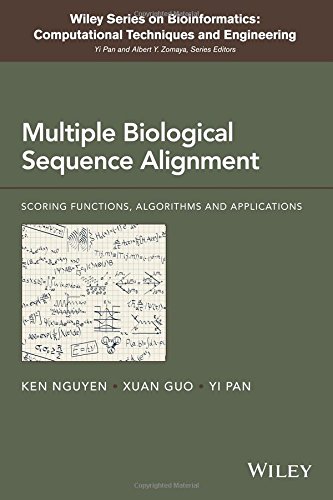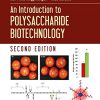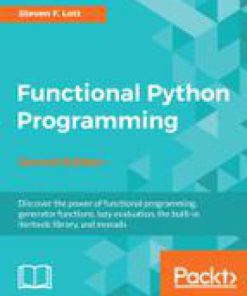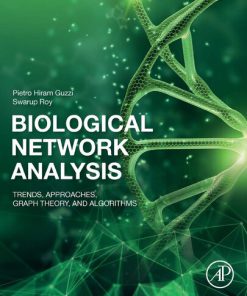Multiple Biological Sequence Alignment Scoring Functions Algorithms and Evaluation 1st Edition by Ken Nguyen, Xuan Guo, Yi Pan 1118229045 9781118229040
$50.00 Original price was: $50.00.$25.00Current price is: $25.00.
Multiple Biological Sequence Alignment Scoring Functions Algorithms and Evaluation 1st Edition by Ken Nguyen, Xuan Guo, Yi Pan – Ebook PDF Instant Download/DeliveryISBN: 1118229045, 9781118229040
Full download Multiple Biological Sequence Alignment Scoring Functions Algorithms and Evaluation 1st Edition after payment.

Product details:
ISBN-10 : 1118229045
ISBN-13 : 9781118229040
Author: Ken Nguyen, Xuan Guo, Yi Pan
Covers the fundamentals and techniques of multiple biological sequence alignment and analysis, and shows readers how to choose the appropriate sequence analysis tools for their tasks This book describes the traditional and modern approaches in biological sequence alignment and homology search. This book contains 11 chapters, with Chapter 1 providing basic information on biological sequences. Next, Chapter 2 contains fundamentals in pair-wise sequence alignment, while Chapters 3 and 4 examine popular existing quantitative models and practical clustering techniques that have been used in multiple sequence alignment. Chapter 5 describes, characterizes and relates many multiple sequence alignment models. Chapter 6 describes how traditionally phylogenetic trees have been constructed, and available sequence knowledge bases can be used to improve the accuracy of reconstructing phylogeny trees. Chapter 7 covers the latest methods developed to improve the run-time efficiency of multiple sequence alignment. Next, Chapter 8 covers several popular existing multiple sequence alignment server and services, and Chapter 9 examines several multiple sequence alignment techniques that have been developed to handle short sequences (reads) produced by the Next Generation Sequencing technique (NSG). Chapter 10 describes a Bioinformatics application using multiple sequence alignment of short reads or whole genomes as input. Lastly, Chapter 11 provides a review of RNA and protein secondary structure prediction using the evolution information inferred from multiple sequence alignments. • Covers the full spectrum of the field, from alignment algorithms to scoring methods, practical techniques, and alignment tools and their evaluations • Describes theories and developments of scoring functions and scoring matrices •Examines phylogeny estimation and large-scale homology search Multiple Biological Sequence Alignment: Scoring Functions, Algorithms and Applications is a reference for researchers, engineers, graduate and post-graduate students in bioinformatics, and system biology and molecular biologists. Ken Nguyen, PhD, is an associate professor at Clayton State University, GA, USA. He received his PhD, MSc and BSc degrees in computer science all from Georgia State University. His research interests are in databases, parallel and distribute computing and bioinformatics. He was a Molecular Basis of Disease fellow at Georgia State and is the recipient of the highest graduate honor at Georgia State, the William M. Suttles Graduate Fellowship. Xuan Guo, PhD, is a postdoctoral associate at Oak Ridge National Lab, USA. He received his PhD degree in computer science from Georgia State University in 2015. His research interests are in bioinformatics, machine leaning, and cloud computing. He is an editorial assistant of International Journal of Bioinformatics Research and Applications. Yi Pan, PhD, is a Regents’ Professor of Computer Science and an Interim Associate Dean and Chair of Biology at Georgia State University. He received his BE and ME in computer engineering from Tsinghua University in China and his PhD in computer science from the University of Pittsburgh. Dr. Pan’s research interests include parallel and distributed computing, optical networks, wireless networks and bioinformatics. He has published more than 180 journal papers with about 60 papers published in various IEEE/ACM journals. He is co-editor along with Albert Y. Zomaya of the Wiley Series in Bioinformatics.
Multiple Biological Sequence Alignment Scoring Functions Algorithms and Evaluation 1st Table of contents:
Chapter 1: Introduction
1.1 Motivation
1.2 The Organization of this Book
1.3 Sequence Fundamentals
Chapter 2: Protein/DNA/RNA Pairwise Sequence Alignment
2.1 Sequence Alignment Fundamentals
2.2 Dot-Plot Matrix
2.3 Dynamic Programming
2.4 Word Method
2.5 Searching Sequence Databases
References
Chapter 3: Quantifying Sequence Alignments
3.1 Evolution and Measuring Evolution
3.2 Substitution Matrices and Scoring Matrices
3.3 GAPS
3.4 Scoring Multiple Sequence Alignments
3.5 Circular Sum Score
3.6 Conservation Score Schemes
3.7 Diversity Scoring Schemes
3.8 Stereochemical Property Methods
3.9 Hierarchical Expected Matching Probability Scoring Metric (HEP)
Chapter 4: Sequence Clustering
4.1 Unweighted Pair Group Method with Arithmetic Mean – UPGMA
4.2 Neighborhood-Joining Method – NJ
4.3 Overlapping Sequence Clustering
Chapter 5: Multiple Sequences Alignment Algorithms
5.1 Dynamic Programming
5.2 Progressive Alignment
5.3 Consistency and Probabilistic MSA
5.4 Genetic Algorithms
5.5 New Development in Multiple Sequence Alignment Algorithms
5.6 Test Data and Alignment Methods
5.7 Results
Chapter 6: Phylogeny in Multiple Sequence Alignments
6.1 The Tree of Life
6.2 Phylogeny Construction
6.3 Inferring Phylogeny from Multiple Sequence Alignments
Chapter 7: Multiple Sequence Alignment on High-Performance Computing Models
7.1 Parallel Systems
7.2 Exiting Parallel Multiple Sequence Alignment
7.3 Reconfigurable-Mesh Computing Models – (R-Mesh)
7.4 Pairwise Dynamic Programming Algorithms
7.5 Progressive Multiple Sequence Alignment ON R-Mesh
Chapter 8: Sequence Analysis Services
8.1 EMBL-EBI: European Bioinformatics Institute
8.2 NCBI: National Center for Biotechnology Information
8.3 GenomeNet and Data Bank of Japan
8.4 Other Sequence Analysis and Alignment Web Servers
8.5 SeqAna: Multiple Sequence Alignment with Quality Ranking
8.6 Pairwise Sequence Alignment and Other Analysis Tools
8.7 Tool Evaluation
Chapter 9: Multiple Sequence for Next-Generation Sequences
9.1 Introduction
9.2 Overview of Next Generation Sequence Alignment Algorithms
Chapter 10: Multiple Sequence Alignment for Variations Detection
10.1 Introduction
10.2 Genetic Variants
10.3 Variation Detection Methods Based on MSA
10.4 Evaluation Methodology
10.5 Conclusion and Future Work
Chapter 11: Multiple Sequence Alignment for Structure Detection
11.1 Introduction
11.2 RNA Secondary Structure Prediction Based on MSA
11.3 Protein Secondary Structure Prediction Based on MSA
11.4 Conclusion and Future Work
People also search for Multiple Biological Sequence Alignment Scoring Functions Algorithms and Evaluation 1st:
multiple sequence alignment analysis
multiple sequence alignment review
multiple sequence alignment biopython
multiple sequence alignment distance matrix
multiple sequence alignment figure
Tags: Multiple Biological, Sequence Alignment, Scoring Functions, Algorithms, Evaluation, Ken Nguyen, Xuan Guo, Yi Pan
You may also like…
Science (General)
Molecular Science of Fluctuations Toward Biological Functions 1st Edition Masahide Terazima
Computers - Programming
Enterprise Java Microservices 1st Edition by Ken Finnigan ISBN 1617294241 978-1617294242
Computers - Programming
Mathematics - Functional Analysis
Engineering
Biology and other natural sciences
Ecotourism s Promise and Peril A Biological Evaluation 1st Edition Daniel T. Blumstein












